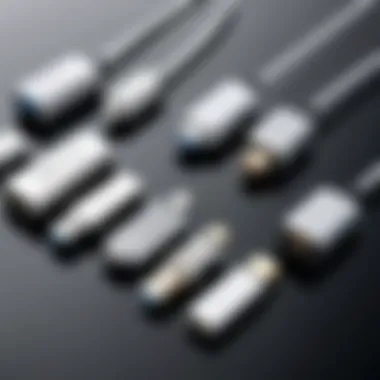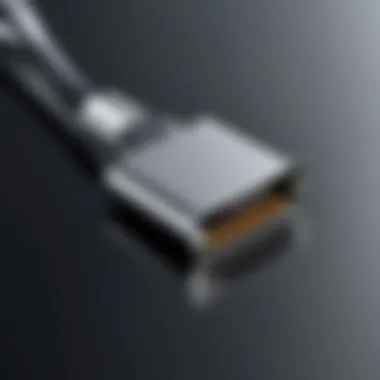Comprehensive Guide to USB Connector Types


Intro
In today's rapidly evolving tech landscape, the role of USB connectors has become increasingly significant. As devices become more interconnected, understanding the various types of USB connectors is essential for IT professionals and tech enthusiasts alike. This exploration delves into the specifics of USB connectors, shedding light on their unique characteristics and applications. With numerous variations in design and functionality, recognizing the right type of connector can enhance compatibility and performance across diverse devices.
This guide aims to equip readers with a succinct yet comprehensive understanding of USB connectors, their historical evolution, and the practical implications in everyday technology use. Through a thorough examination, readers will gain insights into how USB connectors can impact productivity and efficiency in various professional settings.
Prologue to USB Connectors
USB connectors are fundamental to modern connectivity solutions. Their role extends beyond mere data transfer; they enable charging and communication between various devices. Understanding these connectors is essential for anyone working in technology. They are ubiquitous in everyday life. Kids, professionals, everyone uses USB connections, often without thinking.
USB, which stands for Universal Serial Bus, was designed to create a standard connection for devices and peripherals. The importance of USB connectors in this context cannot be overstated. They simplify the way we connect computers with devices such as printers, cameras, and smartphones, providing ease of use and uniformity.
History of USB Technology
The history of USB technology traces back to the mid-1990s. In 1994, a group of companies, including Intel and Microsoft, established the USB standard. The main goal was to simplify the connectivity process and reduce the number of cables required. Before USB, connecting devices often involved various connectors, which could be confusing and frustrating. The first version, USB 1.0, was released in January 1996. It could support data transfer speeds of up to 1.5 Mbps.
The introduction of USB 2.0 in April 2000 brought major improvements. It increased the data transfer speed significantly to 480 Mbps. With its rising popularity, USB connectors quickly became the standard method for connecting devices. Over the years, further advancements led to the development of USB 3.0 and beyond, boasting even higher speeds and capabilities.
Significance of USB in Modern Technology
In today's world, USB connectors represent a cornerstone of digital life. The versatility of USB has allowed it to permeate various industries such as consumer electronics, automotive, and IT. They not only facilitate data transfer but also provide power supply, making it possible to charge devices quickly.
Additionally, USB technology has stood up to the test of time due to its backward compatibility. Older USB devices can still connect using newer connectors. This compatibility ensures a seamless user experience, greatly appealing to tech professionals. The increasing adoption of USB Type-C is evidence of how technology continues to evolve, while still being grounded in its original purpose: to facilitate easy and standardized connectivity.
"The invention of USB connectors simplified the connection landscape, paving the way for modern devices to communicate effortlessly."
Overview of USB Standards
The understanding of USB standards is critical for anyone working with technology today. USB, or Universal Serial Bus, protocols have evolved significantly since their inception, shaping how devices communicate and share power. For IT professionals and tech enthusiasts, knowing these standards is essential for ensuring compatibility and optimizing performance in various applications. Each evolution of the USB standard brought improvements in data transfer rates, power delivery capabilities, and overall efficiency.
The USB standards lay the foundation for device interoperability. As devices continue to diversify in functionality and power, the ability to connect seamlessly becomes more vital. Thus, examining each standard helps in grasping how they influence our daily tech interactions and the critical aspects of choosing the right USB connector.
USB 1. and 1.
USB 1.0 debuted in 1996, providing a significant leap in connectivity by allowing up to 1.5 Mbps for low-speed devices and 12 Mbps for full-speed devices. USB 1.1, introduced in 1998, corrected various compatibility issues and became widely adopted. These versions laid the groundwork for peripheral devices linking to computers without the need for specialized ports. Primarily, devices like mice and keyboards utilized these standards, forming a crucial part of everyday computing.
Key characteristics of USB 1.0 and 1.1 include:
- Support for both high-speed and low-speed peripherals.
- Simple plug-and-play architecture.
- Enhanced compatibility with existing devices through USB 1.1.
USB 2.
In 2000, USB 2.0 emerged, marking a substantial upgrade with a maximum data transfer rate of 480 Mbps. This new standard facilitated faster file transfers, which became especially important as multimedia content proliferated. USB 2.0 reinforced power delivery and data management, enabling devices like printers, scanners, and external drives to benefit significantly from this enhancement.
Moreover, USB 2.0 supported high-bandwidth class devices, which led to the development of various peripherals that became staples in both personal and professional environments:
- Hard drives and flash drives for data storage.
- Cameras and other media devices for quick transfers.
- Enhanced charging capabilities for devices such as smartphones.
USB 3. and 3.
Launched in 2008, USB 3.0 introduced what is known as SuperSpeed USB, capable of data transfer rates up to 5 Gbps, further increasing the efficiency of data transfers and charging. This standard significantly affected external hard disk performance, as large amounts of data could be moved quickly. USB 3.1 followed suit in 2013, with the introduction of SuperSpeed+, elevating the maximum speed to 10 Gbps and offering improved power management.
The USB 3.0 and 3.1 specifications brought forth not just speed but also:
- Enhanced power delivery systems, often reaching up to 900 mA per port.
- New connectors which improved functionality and design aesthetics.


USB 3. and USB4
The evolution continued with USB 3.2, introduced in 2017, which simplified the naming conventions while providing speeds up to 20 Gbps. USB4 made its debut in 2019, bringing significant advancements by merging Thunderbolt 3 capabilities under its umbrella. The introduction of USB4 marked a turning point in USB standards, promoting a single cable solution for data and power.
Important enhancements seen in USB 3.2 and USB4 include:
- Compatibility with previous USB standards while pushing the envelope for performance.
- The ability to share data and power through the same cable, reducing clutter and improving efficiency.
"Understanding USB standards is not just about knowing the numbers; it is crucial for harmonizing interactions among devices and their respective capabilities."
In summary, the USB standards have continually evolved to meet the requirements of modern technology. As we deepen our knowledge of each standard, we acquire the tools necessary for making informed choices regarding connections, maximizing the performance of our devices.
Types of USB Connectors
Understanding the various types of USB connectors is essential for IT professionals and tech enthusiasts. This section delves into the key characteristics, advantages, and specific applications of each USB type. By analyzing these elements, you can make informed decisions on which connector best suits your needs. The connectors play a significant role in data transfer, device charging, and compatibility with modern technology.
USB Type-A
Description and Characteristics
USB Type-A connectors are perhaps the most recognizable of all USB types. They have a flat, rectangular shape that enables easy connection with various devices. One key characteristic is their versatility; Type-A ports are found on computers, chargers, and even televisions. This makes them a highly beneficial choice for general-purpose usage, as they can easily connect to a multitude of peripherals. While the original USB Type-A allows for data transfer speeds of up to 1.5 Mbps, advancements have increased this cap to 20 Gbps with USB 3.2. A notable disadvantage is that Type-A connectors are not reversible; ensuring a correct orientation is necessary.
Common Use Cases
USB Type-A is widely used for connecting peripherals such as keyboards, mice, and external hard drives. Its broad compatibility makes it a go-to for most users. One key use case is in computers, where USB Type-A ports facilitate easy access to external devices. However, as technology progresses toward symmetrical designs, the non-reversible nature of Type-A connectors may become less appealing.
USB Type-B
Description and Characteristics
USB Type-B connectors are designed primarily for devices such as printers and external hard drives. They have a square shape with beveled corners, which aids in specific connections. This distinct shape allows for a dedicated connection, ensuring stability during data transfer. Importantly, USB Type-B connectors support various standards, including USB 2.0 and 3.0. A disadvantage is their limited application outside specific devices, which can restrict compatibility in a broader context.
Common Use Cases
Type-B connectors are found mainly in printers and audio interfaces, providing a strong and reliable connection. They are less commonly used for general devices, making them suitable for niche applications. Their specific nature is an advantage in scenarios requiring a robust link between set devices but may limit usability across a broader range of gadgets.
USB Mini
Description and Characteristics
USB Mini connectors are smaller than their Type-A and Type-B counterparts. They were popular in early portable electronics, such as camcorders and MP3 players. Their compact size is a significant advantage since it allows for lightweight, portable devices. However, their popularity has waned due to the emergence of more efficient connectors like USB Micro. This connector's limited application extent makes it a less versatile choice in today's tech environment.
Common Use Cases
The primary use case for USB Mini connectors is in legacy devices like older cameras and early smartphones. While they were once crucial for connecting portable devices, many users have migrated to more modern connections. The unique footprint of USB Mini can be an advantage in niche use cases but poses compatibility challenges with newer technology.
USB Micro
Description and Characteristics
USB Micro connectors are slimmer than Mini connectors, designed for small devices like smartphones and tablets. Their high transfer speeds and compact form factor make them a favorable option. A significant characteristic of USB Micro is its reversible design in some versions, making plugging in easier. One disadvantage is that continual insertion and removal can lead to wear and probable damage over time, reducing durability.
Common Use Cases
USB Micro connectors are prevalent in smartphones, tablets, and some cameras. They enable quick data transfer and charging, essential features in mobile technology. Their small size allows for usage in tighter spaces, making them a common choice in pocket electronics. However, their fragility may be a concern for heavy users waiting to maintain longevity.


USB Type-C
Description and Characteristics
USB Type-C is the latest standard, designed for high efficiency and usability. It features a slim, reversible connector that allows for easy plugging in either orientation. Its characteristics support data transfer speeds up to 40 Gbps and a power delivery capacity of 100 watts, making it a powerful choice for modern devices. While its versatility in connecting various devices is a significant advantage, Type-C connectors can vary in terms of speed and functionality based on specific cables and ports.
Common Use Cases
USB Type-C connectors are increasingly used in laptops, tablets, and smartphones, reflecting the trend toward universal connectivity. They facilitate fast charging and high-speed data transfer, catering to the needs of today’s tech users. Their widespread adoption signifies the transition to more advanced technology while offering future-proofing opportunities. Users may face compatibility concerns with older devices requiring the use of adapters.
Differences Between USB Types
Understanding the differences between various USB types is crucial for anyone working in the technology sector. These differences determine how devices communicate, the speed they operate at, and the power they can draw. This information is essential for IT professionals who must choose the correct connectors and cables for their devices. Not only does this influence performance, but it also impacts compatibility across a wide range of hardware.
Data Transfer Speeds
Data transfer speed varies greatly between USB types. USB 2.0, for instance, supports a transfer speed of up to 480 Mbps. This was a significant upgrade compared to its predecessors, USB 1.0 and 1.1, which were limited to 12 Mbps. In modern applications, USB 3.0 and later standards offer speeds ranging from 5 Gbps to 40 Gbps for USB 4. Understanding these speeds helps in selecting the right connection for specific tasks, whether it involves data backup, firmware updates, or streaming high-definition content.
Power Delivery Capacities
Another essential difference among USB types is their power delivery capacity. USB Type-A generally provides up to 2.5W, making it suitable for small devices. USB Type-C, however, can deliver up to 100W, making it ideal for charging laptops and powering larger devices. This capability becomes critical in environments where multiple devices are used, and efficient charging is necessary. Knowing which USB type can supply adequate power ensures all devices operate optimally without risking damage or malfunction.
Physical Characteristics
Physical characteristics of USB connectors also play an important role. The size and shape of connectors can impact usability and compatibility. For example, USB Type-A has a standardized rectangular shape, while USB Type-C has a reversible design that allows for easier connections. Furthermore, the durability of connectors varies; Type-C connectors are designed to withstand more insertions compared to older types. This knowledge aids in making informed decisions when selecting connectors for specific applications, reducing wear and tear on devices.
"Choosing the right USB type can enhance device performance and ensure efficient data transfer and charging."
In summary, understanding these differences is vital not just for selecting the correct USB cable or port, but also for ensuring that all devices function seamlessly together.
Compatibility Considerations
The significance of compatibility in USB connectors cannot be understated. In a world full of diverse devices, ensuring that connectors work seamlessly across different technology platforms is essential. With various USB types having emerged over the years, compatibility plays a crucial role in maintaining user experience, convenience, and functionality. This section addresses the critical components of compatibility, focusing on backward compatibility and device support. Understanding these facets will aid IT professionals and tech enthusiasts in choosing the right connectors for their equipment.
Backward Compatibility
Backward compatibility is a core feature of USB technology, allowing newer USB standards to maintain functionality with older devices. This characteristic ensures that users do not face obsolescence when upgrading their devices or peripherals. For instance, USB 3.0 ports can accommodate USB 2.0 devices, allowing for continued use of pre-existing hardware.
The advantages of backward compatibility include:
- Cost efficiency: Users can retain their old devices, avoiding the need for replacement.
- Versatility: One can use a variety of devices without worrying about compatibility.
- Simplified user experience: Users can focus on functionality without needing to navigate complex compatibility issues.
When selecting devices or connectors, one should always verify that new hardware can interact with existing technology.
Device Support
Device support refers to the range of devices compatible with specific USB connector types. This factor is increasingly important as technology evolves and manufacturers offer new solutions. Different connector types often serve unique purposes, and understanding this can guide professionals in making informed decisions.
Many devices like printers, external hard drives, smartphones, and chargers use various USB connector types. The support for these devices often depends on the USB version:
- USB Type-A: Primarily used in computers and chargers, these connectors offer broad compatibility.
- USB Type-C: Gaining traction among newer smartphones, laptops, and peripherals, Type-C connectors provide both power and data transfer capabilities.
- Micro USB: Found in older smartphones and devices, its use is declining in favor of Type-C.
It is vital to consider device support to avoid mismatches that could hinder performance. Thorough research on devices is an essential part of ensuring that selected USB connectors will meet specific needs.
Emerging Trends in USB Technology


The landscape of USB technology is continually evolving. In this section, we will examine some of the most significant emerging trends that are shaping the future of USB connectors. These changes will impact data transfer capabilities, device charging methods, and overall user experiences.
Innovations in USB-C
USB-C has gained tremendous traction due to its versatility and capability. It offers a reversible design and supports various protocols like Thunderbolt 3 and DisplayPort. This adaptability opens a vast array of possibilities for consumers and professionals alike.
One of the key innovations within USB-C technology is the integration of power delivery features. This allows devices to draw higher wattages and charge faster than they did with previous USB types. For example, laptops can now recharge from external power banks that are equipped with USB-C.
Additionally, data transfer speeds have seen impressive growth with USB-C. The USB 3.2 standard, which is supported by USB-C, can achieve speeds of up to 20 Gbps. As more devices adopt USB-C technology, the need for high-speed data transfer becomes critical. This means shifting away from older USB types.
Moreover, manufacturers are now looking into implementing advanced features such as multi-port adapters and docks that utilize USB-C. With a single cable, users can connect their devices to multiple peripherals, such as monitors and hard drives, enhancing productivity and organization.
"The future of devices relies on a unified approach with USB-C leading the way."
Future of USB Standards
As USB technology progresses, future standards are developing to meet the growing needs of consumers and technology professionals. USB4 is one significant standard on the horizon. This standard is built on the foundation of Thunderbolt 3, promoting unparalleled performance and compatibility. USB4 aims to consolidate data, video, and power into one universal connector.
The transition to USB4 will also standardize the capabilities across devices. This standardization is essential for manufacturers as it simplifies design and manufacturing processes. Moreover, users will benefit from a wider range of devices that can share common functionalities, reducing confusion over which cable fits which device.
Another notable consideration in the future of USB standards is sustainability. Manufacturers are increasingly focusing on producing cables and connectors that are more environmentally friendly. This trend is driven by consumer awareness and regulatory pressures regarding waste and sustainability.
Practical Applications of USB Connectors
USB connectors have revolutionized the way we transfer data and power between devices. Their widespread use reflects their practicality in daily technology interaction. In this section, we will look at two significant applications: data transfer and charging solutions. These applications not only highlight the versatility of USB connectors but also their critical roles in modern operations. Understanding these applications is essential for IT professionals and tech enthusiasts alike, as it aids in optimizing their use.
Data Transfer Solutions
Data transfer is perhaps the most recognized function of USB connectors. They allow quick, reliable transfer of data between various devices. This is beneficial in diverse scenarios, such as:
- Transferring files: From computers to external drives or from smartphones to laptops, USB connectors make file transfers seamless. High-speed standards like USB 3.0 facilitate rapid data movement, saving users time.
- Backing up important data: External hard drives or flash drives use USB interfaces to connect and create backups of critical files. This is vital for professionals who handle sensitive information.
- Device synchronization: USB connectors enable synchronization between devices, such as phones and computers. Regular syncing can help maintain updated information across platforms.
Unsurprisingly, the effectiveness of USB in data transfer has made it an industry standard. Users appreciate the simplicity and speed that these connectors provide. Moreover, USB connectors have evolved to support larger data volumes, something crucial in today’s data-driven environment.
Charging Solutions
Alongside data transfer, charging solutions are another primary application of USB connectors. They fulfill a fundamental need as devices increasingly rely on battery power. Key points regarding charging solutions include:
- Universal compatibility: Many devices, from smartphones to power banks, adopt USB connectors for charging. This universality reduces the number of cables and chargers one must carry.
- Quick charging capabilities: Advances in technology, especially within USB-C, have led to faster charging options. This is particularly relevant for users who depend on their devices for work or entertainment.
- Power delivery standards: Many modern USB types support power delivery capabilities. This allows devices to negotiate optimal charging rates, improving efficiency.
In summary, USB connectors serve essential functions in data transfer and charging solutions. Their versatility allows users to enjoy a more convenient and efficient technological experience. Both applications highlight the significance of USB connectors in enhancing user interactions with technology, making them an indispensable component of everyday life.
Closure and Recommendations
In the modern technological landscape, understanding USB connectors is vital for IT professionals and tech enthusiasts alike. This section distills the insights shared throughout the article, emphasizing the significance of selecting the appropriate USB connector for specific applications. The rise of diverse USB types underpin the necessity for a sound comprehension of their respective utilities. Ignoring these elements may lead to inefficiencies or inadequate connections, impacting device performance and user experience.
Selecting the Right USB Connector
When it comes to choosing a USB connector, several factors must be taken into account:
- Device compatibility: Not every device supports every type of connector. USB Type-C, for instance, is becoming standard in new devices, yet many older peripherals still utilize USB Type-A or USB Mini. Checking the specifications of both the device and the cables is crucial.
- Usage requirements: Different tasks necessitate varied connectors. For high-speed data transfers and efficient power delivery, USB 3.1 or USB4 may be preferred. Conversely, for lesser demands, a standard USB 2.0 connection might suffice.
- Physical environment: Some environments may call for connectors designed for durability and resistance, such as those used in industrial settings. This means that choosing a robust connector type can save time and costs in the long run.
Properly assessing these elements ensures that the chosen connector is not only effective but also aligns with the specific needs of the user. It is also wise to remain informed about evolving standards and emerging technologies, which can provide substantial benefits in both speed and functionality.
The End on USB Connector Evolution
The evolution of USB connectors mirrors the rapid advancements in technology. Each new type introduced serves a distinct purpose, enhancing the user experience through better power delivery, increased data transfer speeds, and improved compatibility.
From the initial USB 1.0 connection to the versatile and universally adopted USB Type-C, each advancement brings fresh capabilities and greater convenience. As the tech landscape continues to evolve, it is clear USB connectors will adapt, driving improvements in productivity and collaboration.
"Understanding the evolution of USB technology is essential for professionals to stay abreast of innovative solutions that can enhance workflows and device interoperability."
In summary, recognizing the importance of USB connectors is not just a matter of practicality; it is an essential aspect of making informed choices when navigating the complexities of modern technology. Staying well-informed about the applicable standards and connector types will empower you to leverage the full potential of your devices.



